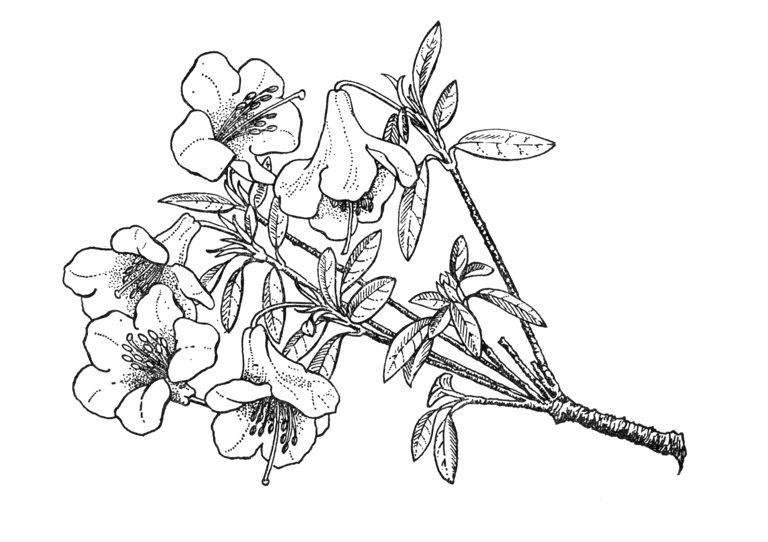A dwarf evergreen shrub forming in the wild a flat, mat-like growth only a few inches high; young shoots slightly scaly; older bark peeling. Leaves aromatic, oblanceolate to narrowly elliptical, rounded to pointed at the mucronate apex, always wedge-shaped at the base, 1 to 11⁄2 in. long, 1⁄8 to 1⁄2 in. wide, glabrous and dark green above, glaucous and very thinly scaly beneath; midrib yellowish; margins decurved; stalk 1⁄4 in. or less long. Flowers solitary or in pairs, opening in May, borne on red stalks up to 1 in. long. Calyx slightly but distinctly five-lobed. Corolla funnel-shaped with reflexed lobes, 1 to 11⁄2 in. wide, scarcely so long, downy all over outside, pinkish purple in various shades, unspotted. Stamens ten, purple, downy quite at the base only; ovary scaly; style rather longer than the corolla, slender, glabrous, red. Bot. Mag., n.s., t. 514. (s. Uniflorum)
R. imperator was discovered by Kingdon Ward in 1926 under the Diphuk La in upper Burma, near the source of the Seinghku river, a feeder of the Irrawaddy, between 10,000 and 11,000 ft, and was introduced by him (KW 6884). His field note reads: ‘A flat thin mat plant, weaving itself over the surface of almost bare granite rocks in a well-shaded gully; thus it is out in the open, but hardly gets any sunshine. Flowers bright unblemished purple, with crimson style… . Leaves aromatic. Very showy.’ Later he wrote: ‘What was remarkable about it was that I found only one plant, which bore only a few flowers, most of which I left for seed, and that returning to the spot five months later I collected only five or six capsules of good seeds; moreover, I never found another plant and no other collector has either’ (Gard. Chron., Vol. 119 (1946), p. 230).
R. imperator first flowered in 1930 and received an Award of Merit four years later when exhibited by Lord Swaythling. It is a beautiful plant for the rock garden but not entirely hardy. Kingdon Ward gave it the nickname “Purple Emperor”, whence the specific epithet imperator.
R. patulum Ward – Kingdon Ward’s statement (see above) that R. imperator has never been rediscovered is doubtfully true. For two years later he himself found and described R. patulum, which is really so near to R. imperator botanically that Cowan and Davidian could find no significant difference except that the scales on the undersurface of the leaves are more closely spaced, being one to one-and-a-half their own diameter apart, against two to six times in R. imperator. A minor difference is that the flowers in R. patulum are often pink and sometimes spotted.
Kingdon Ward found this species in the Delei valley, Mishmi Hills, at 12,000 to 13,000 ft, 40 miles or so to the north-west of the type-locality of R. imperator. According to his field note (KW 8260) it makes a perfectly prostrate creeper forming extensive mats on steep rock or earth slopes, fully exposed. It is just as fine a species as its ally, but has the reputation of being more difficult to cultivate.


